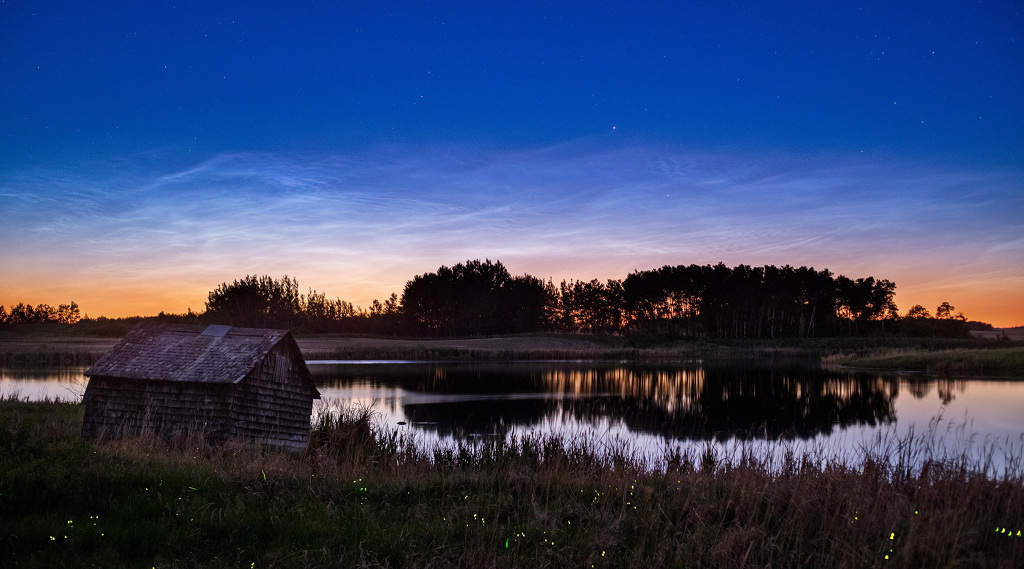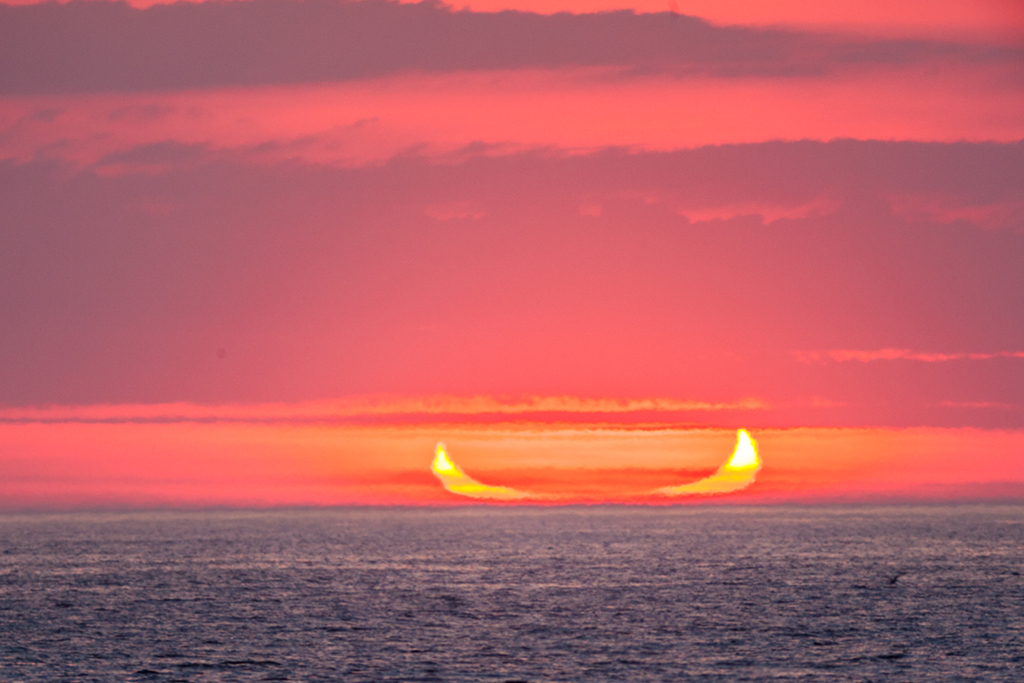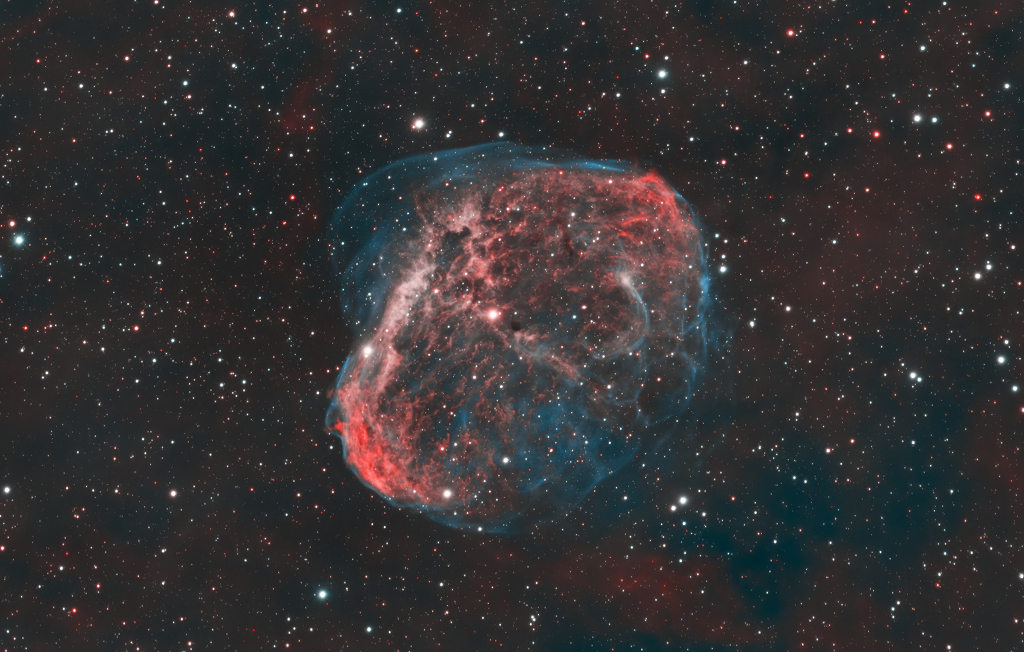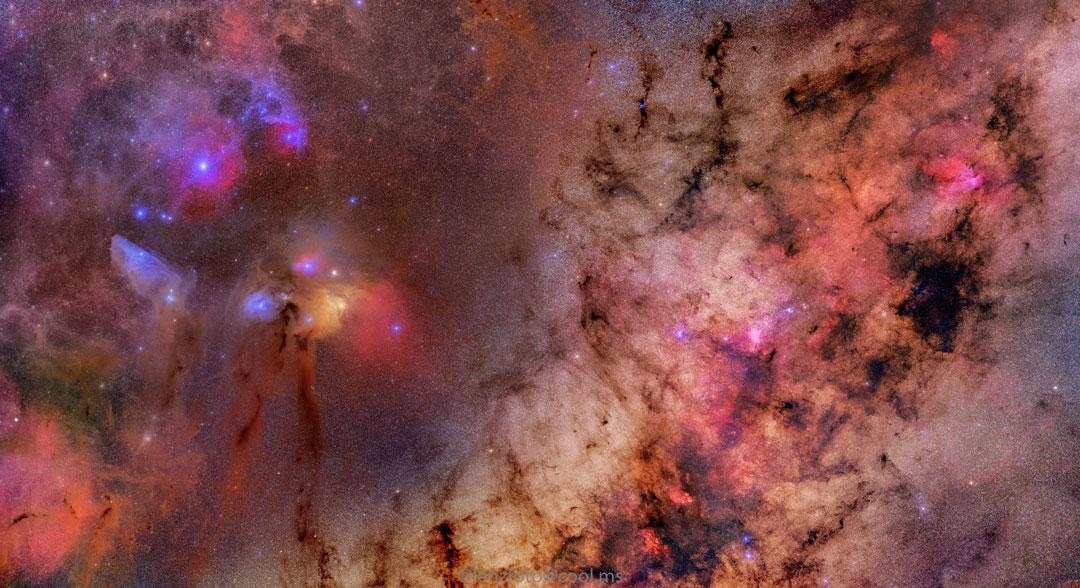Nombre total de pages vues
22/06/2021
19/06/2021
ASTRONOMY - Northern Summer Twilight
2021 June 19
Image Credit & Copyright: Justin Anderson
Explanation: Nights grow shorter and days grow longer as the summer solstice approaches in the north. Usually seen at high latitudes in summer months, noctilucent or night shining clouds begin to make their appearance. Drifting near the edge of space about 80 kilometers above the Earth's surface, these icy clouds were still reflecting the sunlight on June 14. Though the Sun was below the horizon as seen north of Forrest, Manitoba, Canada, they were caught in a single exposure of a near midnight twilight sky. Multiple exposures of the foreground track the lower altitude flash of fireflies, another fleeting apparition shining in the summer night.
18/06/2021
ASTRONOMY - Devil Horns from a Ring of Fire
2021 June 18
Image Credit & Copyright: Madhup Rathi
Explanation: Atmospheric refraction flattened the solar disk and distorted its appearance in this telescopic view of an Atlantic sunrise on June 10. From Belmar, New Jersey on the US east coast, the scene was recorded at New Moon during this season's annular solar eclipse. The Moon in partial silhouette gives the rising Sun its crescent shape reminding some of the horns of the devil (or maybe a flying canoe ...). But at its full annular phase this eclipsed Sun looked like a ring of fire in the heavens. June's annular solar eclipse followed on the heels of the total lunar eclipse of late May's Full Moon. Of course, that total lunar eclipse was a dramatic red Blood Moon eclipse.
17/06/2021
ASTRONOMY - NGC 6888: The Crescent Nebula
2021 June 17
Image Credit & Copyright: Joe Navara, Glenn Clouder, Russell Discombe
Explanation: NGC 6888, also known as the Crescent Nebula, is a about 25 light-years across blown by winds from its central, bright, massive star. A triumvirate of astroimagers ( Joe, Glenn, Russell) created this sharp portrait of the cosmic bubble. Their telescopic collaboration collected over 30 hours of narrow band image data isolating light from hydrogen and oxygen atoms. The oxygen atoms produce the blue-green hue that seems to enshroud the detailed folds and filaments. Visible within the nebula, NGC 6888's central star is classified as a Wolf-Rayet star (WR 136). The star is shedding its outer envelope in a strong stellar wind, ejecting the equivalent of the Sun's mass every 10,000 years. The nebula's complex structures are likely the result of this strong wind interacting with material ejected in an earlier phase. Burning fuel at a prodigious rate and near the end of its stellar life this star should ultimately go out with a bang in a spectacular supernova explosion. Found in the nebula rich constellation Cygnus, NGC 6888 is about 5,000 light-years away.
16/06/2021
PRATIQUE/POURQUOI - Pourquoi y a-t-il des "trous d'air" en avion ?
ASTRONOMY - Scorpius Enhanced
2021 June 16
Image Credit & Copyright: Stefan Lenz
Explanation: If Scorpius looked this good to the unaided eye, humans might remember it better. Scorpius more typically appears as a few bright stars in a well-known but rarely pointed out zodiacal constellation. To get a spectacular image like this, though, one needs a good camera, a dark sky, and some sophisticated image processing. The resulting digitally-enhanced image shows many breathtaking features. Diagonal across the image right is part of the plane of our Milky Way Galaxy. Visible there are vast clouds of bright stars and long filaments of dark and intricate dust. Rising vertically on the image left are dark dust bands known as the Dark River. Several of the bright stars on the left are part of Scorpius' head and claws, and include the bright star Antares. Numerous red emission nebulas, blue reflection nebulas, and dark filaments became visible as the deep 17-hour expo image developed. Scorpius appears prominently in southern skies after sunset during the middle of the year.
15/06/2021
ASTRONOMY - Zhurong: New Rover on Mars
2021 June 15
Image Credit: China National Space Administration
Explanation: There's a new rover on Mars. In mid-May, China's Tianwen-1 mission delivered the Zhurong rover onto the red planet. As Mars means Planet of Fire in Chinese, the Zhurong rover's name means, roughly, God of Fire in Chinese mythology. Zhurong landed in northern Utopia Planitia, the largest known impact basin in the Solar System, and an area reported to have much underground ice. Among many other scientific instruments, Zhurong carries ground-penetrating radar that can detect ice buried even 100-meters deep. Car-sized Zhurong is pictured here next to its landing base. The image was snapped by a remote camera deployed by the rolling rover. Zhurong's planned 90-day mission includes studying the geology, soil, and atmosphere of Mars in Utopia Planitia.
14/06/2021
11/06/2021
ASTRONOMY - Orion and the Ocean of Storms
2025 December 13 Orion and the Ocean of Storms Image Credit: NASA , Artemis 1 Explanation: On December 5, 2022, a camera on board the u...

-
2022 September 26 All the Water on Planet Earth Illustration Credit: Jack Cook, Adam Nieman, Woods Hole Oceanographic Institution ; Data ...
-
2025 May 11 The Surface of Venus from Venera 14 Image Credit: Soviet Planetary Exploration Program , Venera 14 ; Processing & Copyri...






